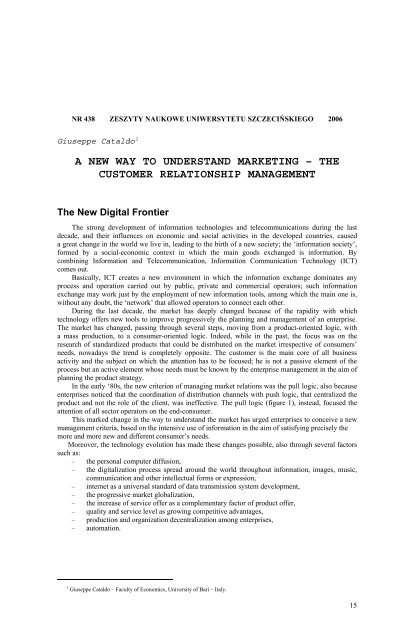- Page 1 and 2: NR 438 ZESZYTY NAUKOWE UNIWERSYTETU
- Page 3 and 4: Spis treściWstęp.................
- Page 5 and 6: Izabela Michalska-Dudek............
- Page 8 and 9: Jarosław Zalejski.................
- Page 10: NR 438 ZESZYTY NAUKOWE UNIWERSYTETU
- Page 15 and 16: It must be specified that the enter
- Page 17 and 18: CRM intelligence systemsAnalysis ap
- Page 19 and 20: NR 438 ZESZYTY NAUKOWE UNIWERSYTETU
- Page 21 and 22: Ogólnoekonomicznewarunki ramoweZaa
- Page 23 and 24: Klienci (Customers):Dostawcy (Custo
- Page 25 and 26: NR 438 ZESZYTY NAUKOWE UNIWERSYTETU
- Page 27 and 28: stanowią wysokie koszty, a także
- Page 29 and 30: NR 438 ZESZYTY NAUKOWE UNIWERSYTETU
- Page 31 and 32: 2001. Najbardziej optymistyczne pro
- Page 33 and 34: (tabela 2). Rynek ten jest ogranicz
- Page 35 and 36: Koszty transportu 3004Koszty admini
- Page 37 and 38: NR 438 ZESZYTY NAUKOWE UNIWERSYTETU
- Page 39 and 40: - relacjami z klientem,- zasobami w
- Page 41 and 42: korzystanie z bankomatów innych ba
- Page 43 and 44: się prognozowaniem tempa rozwoju b
- Page 45 and 46: NR 438 ZESZYTY NAUKOWE UNIWERSYTETU
- Page 47 and 48: Budowanie zatem dobrej strategii ma
- Page 49 and 50: strategii marketingowych. W artykul
- Page 51 and 52: Z przeprowadzonej analizy wynika,
- Page 53 and 54: SummaryBARRIERS AND PROSPECTS OF TH
- Page 55 and 56: Urząd Nadzoru Ubezpieczeń Społec
- Page 57 and 58: Wszystkie osoby chcące lub będąc
- Page 59 and 60: Wśród ludzi młodych najważniejs
- Page 61 and 62:
Połowa ankietowanych osób z wyksz
- Page 63 and 64:
Tabela 1Szkoły myślenia i ich wp
- Page 65 and 66:
sam industrializm. Stał się swois
- Page 67 and 68:
w której zawiera się wartość. O
- Page 69 and 70:
NR 438 ZESZYTY NAUKOWE UNIWERSYTETU
- Page 71 and 72:
Kulturyceremonialne ihierarchiczneK
- Page 73 and 74:
Radzenie sobie z różnicami kultur
- Page 75 and 76:
NR 438 ZESZYTY NAUKOWE UNIWERSYTETU
- Page 77 and 78:
ona wiele zalet i jest szeroko stos
- Page 79 and 80:
podmioty mające za zadanie prowadz
- Page 81 and 82:
NR 438 ZESZYTY NAUKOWE UNIWERSYTETU
- Page 83 and 84:
- nawozy mineralne (wieloskładniko
- Page 85 and 86:
5. 1999-2001 - okres dekoniunktury
- Page 87 and 88:
4. Zintegrowanie portu Police w ram
- Page 89 and 90:
Branża lotnicza należy do jednych
- Page 91 and 92:
Na rynku przewozów krajowych panow
- Page 93 and 94:
Strategia koncentracji opiera się
- Page 95 and 96:
działalność dwóch segmentów pr
- Page 97 and 98:
Wymienione zakresy świadczenia us
- Page 99 and 100:
Rys. 2. Konsumenci usług weterynar
- Page 101 and 102:
SummaryVETERINARY SERVICES - AREA O
- Page 103 and 104:
odzwierciedlenie w koncepcji symbio
- Page 105 and 106:
Zarządzanie wiedzą - budowa intel
- Page 107 and 108:
SummaryTHE PARTNER’S KNOWLEDGE MA
- Page 109 and 110:
kontakty z usługodawcą. Istotnym
- Page 111 and 112:
siebie zależne. Klimat organizacji
- Page 113 and 114:
Obszary zarządzania zasobami ludzk
- Page 115 and 116:
oraz wyznacza indywidualną ścież
- Page 117 and 118:
małych i średnich firm. Takiej wi
- Page 119 and 120:
Bardzo długo w teorii marketingu,
- Page 121 and 122:
Znajomość pochodzenia produktów
- Page 123 and 124:
grup produktów w zależności od C
- Page 125 and 126:
NR 438 ZESZYTY NAUKOWE UNIWERSYTETU
- Page 127 and 128:
i przestrzeganie norm z myślą o o
- Page 129 and 130:
zapewniają zaangażowanie, wzajemn
- Page 131 and 132:
NR 438 ZESZYTY NAUKOWE UNIWERSYTETU
- Page 133 and 134:
oddziaływania za pomocą marketing
- Page 135 and 136:
PodsumowanieRynek nasienny stanowi
- Page 137 and 138:
W szerszym ujęciu obsługę klient
- Page 139 and 140:
- we właściwym stanie,- po właś
- Page 141 and 142:
- szkolenia personelu z zakresu obs
- Page 143 and 144:
NR 438 ZESZYTY NAUKOWE UNIWERSYTETU
- Page 145 and 146:
wiekowych, które obecnie stanowią
- Page 147 and 148:
Dostosowanie się do czynników ksz
- Page 149 and 150:
Ostatnią, wynikającą ze stworzon
- Page 151 and 152:
terytorialnego zmieniają sposób i
- Page 153 and 154:
sprawdzić oczekiwania i obawy spo
- Page 155 and 156:
NR 438 ZESZYTY NAUKOWE UNIWERSYTETU
- Page 157 and 158:
klienta jak i firmy. Tylko dokładn
- Page 159 and 160:
analizowanych przedsiębiorstw, nie
- Page 161 and 162:
wartości oraz „ducha” kooperac
- Page 163 and 164:
Ogromną rolę w tworzeniu relacji
- Page 165 and 166:
wyrafinowanych instrumentów finans
- Page 167 and 168:
f) doradztwa w zakresie ubezpiecze
- Page 169 and 170:
NR 438 ZESZYTY NAUKOWE UNIWERSYTETU
- Page 171 and 172:
marketingowej w walce z konkurencj
- Page 173 and 174:
merytoryczny personelu bankowego, d
- Page 175 and 176:
że „marketing relacji to tworzen
- Page 177 and 178:
Satysfakcja konsumentaNiskaWysokaS
- Page 179 and 180:
Najwyżej cenione czynniki kształt
- Page 181 and 182:
WSK = (W 1 C 1 + W 2 C 2 + W 3 C 3
- Page 183 and 184:
Z przeprowadzonej analizy wynika,
- Page 185 and 186:
PodsumowanieDostarczenie przez biur
- Page 187 and 188:
e) określić sposób finansowania
- Page 189 and 190:
odpowiedzi ich organizator przydzie
- Page 191 and 192:
NR 438 ZESZYTY NAUKOWE UNIWERSYTETU
- Page 193 and 194:
The role of frontline employees in
- Page 195 and 196:
SummaryService marketing researcher
- Page 197 and 198:
SatysfakcjaTransakcyjnaSkumulowana-
- Page 199 and 200:
Omówiony mechanizm współzależno
- Page 201 and 202:
Założenie zarządzania portfelem
- Page 203 and 204:
popularyzację i rozwój produkcji
- Page 205 and 206:
z pomysłami LGD mających podobne
- Page 207 and 208:
wdrożenia koncepcji marketingu par
- Page 209 and 210:
można zahamować, a nawet wyelimin
- Page 211 and 212:
Koncepcja CRM zakłada realizację
- Page 213 and 214:
Determinanty udanego wdrożenia CRM
- Page 215 and 216:
NR 438 ZESZYTY NAUKOWE UNIWERSYTETU
- Page 217 and 218:
Motywy lojalności w usługach z in
- Page 219 and 220:
StreszczenieIntensywność kontaktu
- Page 221 and 222:
klientów, które łatwiej zaspokoi
- Page 223 and 224:
klientowi dodatkową, jedyną w swo
- Page 225 and 226:
NR 438 ZESZYTY NAUKOWE UNIWERSYTETU
- Page 227 and 228:
ModelLojalność wobec marki oparta
- Page 229 and 230:
Kreowanie lojalności klientów prz
- Page 231 and 232:
Tak szeroka inicjatywa przedsiębio
- Page 235 and 236:
Jak zauważa Ph. Kotler, konsumenci
- Page 237 and 238:
klientów do poszukiwań samych pom
- Page 239 and 240:
Identyfikacja docelowychsłuchaczyZ
- Page 241 and 242:
wysokiej nadal nie dostrzega potrze
- Page 243 and 244:
Często jednak zdarzają się sytua
- Page 245 and 246:
NR 438 ZESZYTY NAUKOWE UNIWERSYTETU
- Page 247 and 248:
wysokość umieszczenia produktu to
- Page 249 and 250:
Rys. 2. Szata graficzna opakowań O
- Page 251 and 252:
Rys. 6. Procentowy udział firmy Wr
- Page 253 and 254:
jest wykorzystywany dorobek psychol
- Page 255:
Podawanie informacji nieprawdziwych
- Page 259 and 260:
Tak jednak się nie dzieje, co wią
- Page 261 and 262:
Należy zaznaczyć, że tożsamoś
- Page 263 and 264:
Techniki public relations służąc
- Page 265 and 266:
nie przez konkurowanie ceną i cią
- Page 267 and 268:
marketingiem relacji i związków (
- Page 269 and 270:
- przeprowadzić rozmowy telefonicz
- Page 271 and 272:
NR 438 ZESZYTY NAUKOWE UNIWERSYTETU
- Page 273 and 274:
grup. Ze względu na to, że nie st
- Page 275 and 276:
ezpośrednia12%prasowa12%radiowa14%
- Page 277 and 278:
4. Reklama zachęca, ale nie zamów
- Page 279 and 280:
Ujednolicenie zasad tworzenia rapor
- Page 281 and 282:
jednak głównie do działalności
- Page 283 and 284:
kanały przekazu, nazywane także
- Page 285 and 286:
Tabela 1Kanały i nośniki komunika
- Page 287 and 288:
podkreślono, że skoro organizacje
- Page 289 and 290:
PromocjanieosobowaTypy i rodzaje pr
- Page 291 and 292:
Tabela 3Wybrane formy i środki rek
- Page 293 and 294:
Bardzo często spotyka się też z
- Page 295 and 296:
Kraków i Poznań, respondentami za
- Page 297 and 298:
się relacjami z pośrednikami w sp
- Page 299 and 300:
narzędzie promocyjne, którego sto
- Page 301 and 302:
Pojęcie marketingu partnerskiego p
- Page 303 and 304:
Z analizy powyższych danych wynika
- Page 305 and 306:
Ocena personelu banków i jego zach
- Page 307 and 308:
WnioskiLojalność klienta nie przy
- Page 309 and 310:
Niezależne dane pierwotne pochodz
- Page 311 and 312:
Wybór środków przekazu jest komp
- Page 313 and 314:
SummaryCRM AND INTEGRATED MARKETING
- Page 315 and 316:
cena decyduje o tym, czy dany obiek
- Page 317 and 318:
za zadanie wspieranie sprzedaży i
- Page 319 and 320:
NR 438 ZESZYTY NAUKOWE UNIWERSYTETU
- Page 321 and 322:
z podobieństwem nadawcy komunikatu
- Page 323 and 324:
ROZDZIAŁ CZWARTYInterakcje między
- Page 325 and 326:
- niepewność związana z możliwo
- Page 327 and 328:
podczas wizyty w fabryce dostawcy,
- Page 329 and 330:
NR 438 ZESZYTY NAUKOWE UNIWERSYTETU
- Page 331 and 332:
w marketingowych jednostkach organi
- Page 333 and 334:
postawy. Z drugiej strony, zachowan
- Page 335 and 336:
NR 438 ZESZYTY NAUKOWE UNIWERSYTETU
- Page 337 and 338:
przekonać i nie boi się pytań or
- Page 339 and 340:
NR 438 ZESZYTY NAUKOWE UNIWERSYTETU
- Page 341 and 342:
Menedżerowie powinni także nauczy
- Page 343 and 344:
nie powinni krytykować, do czego m
- Page 345 and 346:
niejasne regulacje prawne i biurokr
- Page 347 and 348:
jaką się zajmuje, jest w dużym s
- Page 349 and 350:
NR 438 ZESZYTY NAUKOWE UNIWERSYTETU
- Page 351 and 352:
Ubiór i powierzchowność są isto
- Page 353 and 354:
w tego typu sytuacjach odbierają h
- Page 355 and 356:
Świadczenie usług handlowych, bę
- Page 357 and 358:
StreszczenieInterakcje międzyludzk
- Page 359 and 360:
NR 438 ZESZYTY NAUKOWE UNIWERSYTETU
- Page 361 and 362:
nieekwiwalentności wymiany i zatrz
- Page 363 and 364:
3. Strategia powinna mieć kompleks
- Page 365 and 366:
Fazy zarządzaniastrategicznegoAnal
- Page 367 and 368:
Podsumowując należy zauważyć,
- Page 369 and 370:
produkcji polskiego przemysłu lekk
- Page 371 and 372:
W ostatnich latach firmy sektora od
- Page 373 and 374:
Marketing w sporcie obejmuje badani
- Page 375 and 376:
dolarów na marketing i promocję z
- Page 377 and 378:
Nike 16 . Największe gwiazdy wspó
- Page 379 and 380:
Mając wiedzę na temat szans stwor
- Page 381 and 382:
W takim ujęciu uwzględniona zosta
- Page 383 and 384:
NR 438 ZESZYTY NAUKOWE UNIWERSYTETU
- Page 385 and 386:
Natomiast marka unikatowa tworzy ta
- Page 387 and 388:
NR 438 ZESZYTY NAUKOWE UNIWERSYTETU
- Page 389 and 390:
nie potrafię wskazać53%Rys. 3. G
- Page 391 and 392:
jak Skoda (3 miejsce), Łada czy Ma
- Page 393 and 394:
NR 438 ZESZYTY NAUKOWE UNIWERSYTETU
- Page 395 and 396:
Czwarty poziom piramidy lojalności
- Page 397 and 398:
− skojarzenia związane z korzyś
- Page 399 and 400:
StreszczenieArtykuł podejmuje prob
- Page 401 and 402:
PRZEDSIĘBIORSTWO (bank)Marketingwe
- Page 403 and 404:
Założone przypuszczenie okazało
- Page 405 and 406:
NR 438 ZESZYTY NAUKOWE UNIWERSYTETU
- Page 407 and 408:
Przedstawione zestawienie wskazuje
- Page 409 and 410:
Duży wpływ na rynek mobile market
- Page 411 and 412:
NR 438 ZESZYTY NAUKOWE UNIWERSYTETU
- Page 413 and 414:
gdzie: R i - ranga ważności i-tej
- Page 415 and 416:
posługiwanie się nazwą przedsię
- Page 417 and 418:
StreszczeniePodstawowym zadaniem pr
- Page 419 and 420:
w późniejszych fazach procesu, w
- Page 421 and 422:
tworzą wsparcie dla adaptacji podm
- Page 423 and 424:
NR 438 ZESZYTY NAUKOWE UNIWERSYTETU
- Page 425 and 426:
jest świadom, jak i te, które są
- Page 427 and 428:
SummaryINNOVATIONS PULLED BY MARKET
- Page 429 and 430:
Problemy demograficzne jak do tej p
- Page 431 and 432:
nawet zamożna osoba będzie posiad
- Page 433 and 434:
NR 438 ZESZYTY NAUKOWE UNIWERSYTETU
- Page 435 and 436:
Zdaniem Ph. Kotlera 9 priorytetowym
- Page 437 and 438:
d) otwarty rynek idei to termin dla
- Page 439 and 440:
Po etapie wstępnego wykreowania ko
- Page 441 and 442:
Sygnałwewnętrznycharakterystykaw
- Page 443 and 444:
nabywanych najczęściej przez klie
- Page 445 and 446:
ROZDZIAŁ SZÓSTYWykorzystanie nowo
- Page 447 and 448:
Digitalizacja produktu jest to inac
- Page 449 and 450:
Najważniejszym z powyższych poję
- Page 451 and 452:
Trzecia z opisywanych, strategia ko
- Page 453 and 454:
korporacyjnych (np. onet.pl) lub vo
- Page 455 and 456:
producenta, zastosowania, ceny. Opr
- Page 457 and 458:
NR 438 ZESZYTY NAUKOWE UNIWERSYTETU
- Page 459 and 460:
przesyłaniem obrazu (videostreamin
- Page 461 and 462:
NR 438 ZESZYTY NAUKOWE UNIWERSYTETU
- Page 463 and 464:
Komunikacja e-mailowaJak już wspom
- Page 465 and 466:
− adresy e-mailowe mogą być dod
- Page 467 and 468:
NR 438 ZESZYTY NAUKOWE UNIWERSYTETU
- Page 469 and 470:
Targetowanie behawioralne i modelow
- Page 471 and 472:
SrodowiskoprojektoweE 1 E 2E nSrodo
- Page 473 and 474:
StreszczenieW artykule przedstawion
- Page 475 and 476:
udowanie trwałych więzi z e-klien
- Page 477 and 478:
Lp.Czas nadesłania odpowiedzi z wy
- Page 479 and 480:
wydawnictwie. W tabeli 2 przedstawi
- Page 481 and 482:
Celem stosowania systemów CRM jest
- Page 483 and 484:
trakcie analiz definiowanych przez
- Page 485 and 486:
W referacie przedstawiono: moduły
- Page 487 and 488:
Pojawienie się nowych rozwiązań
- Page 489 and 490:
indywidualne relacje narzędziem ma
- Page 491 and 492:
SummaryTHE INFLUENCE OF ELECTRONIC
- Page 493 and 494:
polega na ich zmianie z oficjalnych
- Page 495 and 496:
Na koniec rozważań dotyczących i
- Page 497 and 498:
LAMSVM JavaJDBCHTML, XML,FLASHPrzeg
- Page 499 and 500:
− modułowa budowa systemu polega
- Page 501 and 502:
NR 438 ZESZYTY NAUKOWE UNIWERSYTETU
- Page 503 and 504:
System IVR umożliwia nawiązanie i
- Page 505 and 506:
− redukcję liczby konsultantów
- Page 507 and 508:
NR 438 ZESZYTY NAUKOWE UNIWERSYTETU
- Page 509 and 510:
i taniej. Te cele można osiągną
- Page 511 and 512:
StronyDecyzjeInicjowanie działania
- Page 513 and 514:
NR 438 ZESZYTY NAUKOWE UNIWERSYTETU
- Page 515 and 516:
w promocji miasta zyskuje sobie cor
- Page 517 and 518:
infrastrukturę techniczną, rozwij
- Page 519 and 520:
o jakość życia swoich obywateli,
- Page 521 and 522:
PodsumowanieAnaliza działań zwią
- Page 523 and 524:
pochłania wiele nakładów, pracy
- Page 525 and 526:
Analiza obecnego wizerunku gminy(ba
- Page 527 and 528:
Poczynając od przyjaznej atmosfery
- Page 529 and 530:
najjaskrawszym przykładem od wielu
- Page 531 and 532:
i produktów za granicą, korzystni
- Page 533 and 534:
(dwie pierwsze w rękach amerykańs
- Page 535 and 536:
NR 438 ZESZYTY NAUKOWE UNIWERSYTETU
- Page 537 and 538:
jawność funkcjonowania władz gmi
- Page 539 and 540:
Badania „Rozwój eGovernment w Po
- Page 541 and 542:
NR 438 ZESZYTY NAUKOWE UNIWERSYTETU
- Page 543 and 544:
− instytucje lokalne, regionalne,
- Page 545:
wykonywaniu tego zadania” 18 . Wo
















